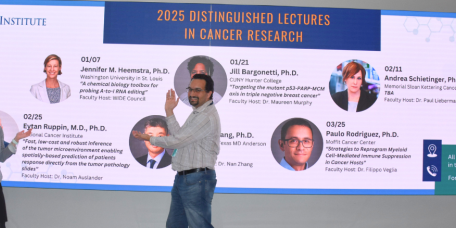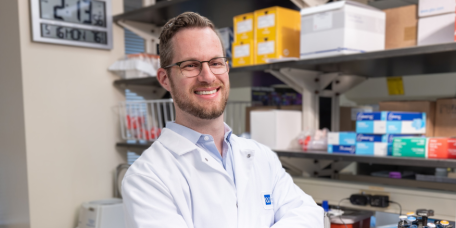The Wistar Institute
The Wistar Institute Hosts Dr. Jen Heemstra, Renowned Researcher Leading the Charge for Excellence in Scientific Mentorship
As part of the Distinguished Lectures in Cancer Research series, Jennifer Heemstra, Ph.D., presented to Wistar faculty and trainees on her scientific research and a professional passion of hers, the importance of mentorship in research. Dr. Heemstra…
The Wistar Institute’s Dr. Anneliese Faustino, Studio Artist, Explores the World of Proteins
Anneliese Faustino, Ph.D., recently joined The Wistar Institute as the associate managing director of the Proteomics Facility. She is also an artist who uses art to advance her science. Here she discusses why proteomic analysis is so critical to mod…
The Wistar Institute Scientists Discover New Weapon to Fight Treatment-Resistant Melanoma
PHILADELPHIA — (February 5, 2025) —The lab of The Wistar Institute’s Jessie Villanueva, Ph.D., has identified a new strategy for attacking treatment-resistant melanoma: inhibiting the gene S6K2. The team published their findings in the paper, “Selec…
The Wistar Institute’s Dr. Kazuko Nishikura Launches Preclinical Testing of New Melanoma Immunotherapy
Wistar professor Kazuko Nishikura, Ph.D., has led the way in foundational biomedical research on RNA for decades. Her laboratory discovered the role genes in the ADAR family play in editing RNA. A new grant from the Melanoma Research Foundation supp…
The Wistar Institute Receives $600,000 Grant to Expand Apprenticeship Programs in its Hubert J.P. Schoemaker Education and Training Center
PHILADELPHIA — (January 30, 2025) — The Wistar Institute’s Hubert J.P. Schoemaker Education and Training Center is expanding its signature apprenticeship programs and bolstering job opportunities in the life science sector thanks to a recent $600,00…
Michela Perego on Life Inside & Outside of the Lab
Cellular biologist Michela Perego, Ph.D., was born in Monza, the capital city of Brianza, a northern Italian province well known for Formula One race car driving. She grew up in a family of non-scientists yet found her passion for science in high sc…
Wistar Scientists Recognized at International Society for Vaccines Conference
Wistar researchers were recognized for their leadership and contributions to vaccinology recently at the International Society for Vaccines (ISV) annual Congress. The conference, held in October in Seoul, also featured presentations by scientists in…
The Wistar Institute’s Head of HIV Cure and Viral Diseases Center Luis Montaner Shares Why He Thinks We Can Attain an HIV Cure
Finding a cure has long been the holy grail of HIV research. Now new discoveries are putting that goal within reach, according to Wistar’s Luis Montaner, D.V.M., D.Phil.
As director of the institute’s new HIV Cure and Viral Diseases Center, Montane…
Newsweek Magazine in Collaboration with Best Practice Institute Recognizes The Wistar Institute in 2025 ‘Excellence Index’
PHILADELPHIA — (December 20th, 2024) — In its annual Excellence Index, Newsweek and the Best Practice Institute has recognized The Wistar Institute as one of the world’s top 1000 companies. Wistar led the way as the top-ranked company in the Healthc…
How The Wistar Institute’s Dr. Dan Claiborne Engineers CAR T Cells to Fight HIV
Assistant professor Daniel Claiborne, Ph.D., pursues one of the hottest up-and-coming areas of research: CAR T cells, which are engineered immune cells designed to attack specific target Dr. Claiborne’s work focuses on HIV. As Dr. Claiborne prepares…









